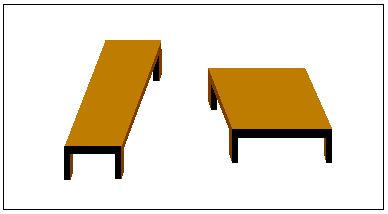T-Junction
-
(See Junctions).
Tapetum
-
Silvery lining behind the retina in some animals active in dim light. Reflects light back through the eye and allows the photoreceptors a second chance to absorb photons.
Table Illusion
-
Although the parallelograms making up the top of the two coffee tables
are exactly the same size (try checking with a cut out piece of paper)
they look different presumably due to our experience with perspective.

Tectopontine Tract
-
Relays information from the colliculus to the cerebellum for further coordination of eye and head movement.
Tectospinal Tract
-
Axons from the colliculus to the upper spinal cord where the neck motor neurons are located. Involved in reflex control of head and neck movements.
Template Matching
-
An object recognition method. Incoming patterns are matched against a set of templates. If there is sufficient overlap between object and template, a match is signaled. Of limited use, primarily in alphanumeric character recognition.
Temporal Hemiretina
-
That portion of the retina that lies lateral to the fovea.
(See also Nasal Hemiretina
and Figure).
Terminators
-
In the context of motion, terminators are those portions of a moving
object which signal unambiguous motion. For a
barber pole
pattern these would be the line ends of the grating, for a translating diamond,
these would be the corners.
-
(See also Aperture
Problem)
Extrinsic Terminators
-
Those terminators that are not created by the end of the object
itself. Rather they are due to occlusion by another surface. Such
terminators play less of a role in determining the perceived direction
of motion than do intrinsic terminators
Intrinsic Terminators
-
Those terminators that are due to the natural end of the object rather
than to occlusion by another surface.
Tetrachromatic Color Vision
-
Color vision based on four cone photoreceptor pigments in the retina. The fourth cone type is sensitive to U.V. light and seen in goldfish.
-
(See also Dichromatic Color Vision
and Trichromatic Color Vision).
Texton
-
(Julesz)
-
The basic textural elements of pre-attentive vision such as elongated blobs or line segments and their terminators which are important for segregation of textures
Texture Segregation
-
Thick Stripes
-
(See Appendix I: Cortical Areas, V2).
Thin Stripes
-
(See Appendix I: Cortical Areas, V2).
Transducin
-
A regulatory g-protein in photoreceptors which stimulates phosphodiesterase molecules and acts as an amplifier of the incoming light signal.
Transformational Apparent Motion
-
Apparent motion in which the presented object(s) appear to change shape, growing or contracting. In the simplest case, the line motion illusion, a line that is presented rapidly after a spot appears to smoothy grow out of the spot. There are many variations of this phenomenon.
(See also Apparent Motion).
Transient Tritanopia Phenomenon
-
Transient blindness for blue test lights is observed in the first few hundred milliseconds after the offset of strong yellow adaptations lights.
Trichromatic Color Vision
-
Color vision based on three cone photoreceptors pigments in the retina
-
(See also Dichromatic Color Vision
and Tetrachromatic Color Vision).
Troland
-
The unit of retinal illuminance defined as T=Lp with L (luminance) expressed
in
 and p (pupil area) in mm2.
Needed as luminance of the light incident on the retina varies with
pupil size. There is a photopic and scotopic troland.
and p (pupil area) in mm2.
Needed as luminance of the light incident on the retina varies with
pupil size. There is a photopic and scotopic troland.